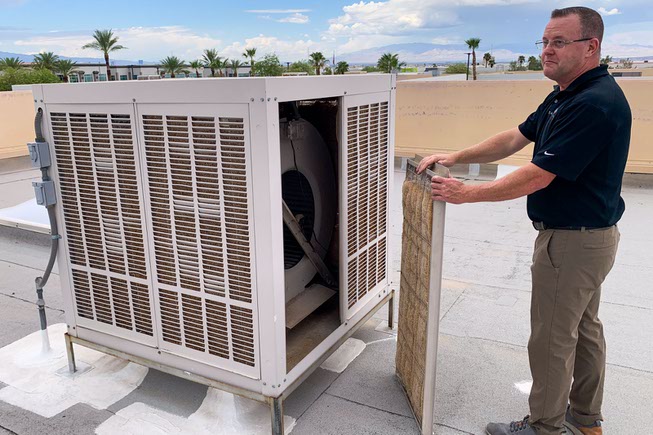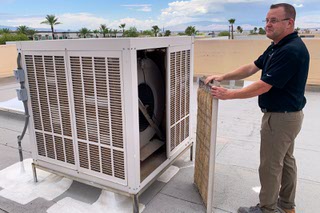
Rhiannon Saegert
Steven Lewis, general manager for the a/c company Ambient Edge, showing their own evaporative cooling unit at their shop in Henderson, Nevada. Thursday, September 14, 2023. Brian Ramos
Monday, Sept. 25, 2023 | 2 a.m.
The Southern Nevada Water Authority has banned evaporative cooling in new commercial buildings because the systems are one of largest consumers of water in Clark County.
The ban went into effect this month but does not apply to businesses that applied for building permits before then.
Instead of evaporative cooling systems, which use a steady stream of water and a fan to blast cool air throughout buildings, new structures will use air conditioning units with a recirculating refrigerant.
Dave Johnson, deputy general manager of the water authority, said the type of large cooling towers found at Las Vegas resorts is the main concern.
Evaporative cooling is the second-largest consumptive use of water in Southern Nevada, behind outdoor irrigation.
It uses about 10% of the region’s annual allotment of water from the drought-stricken Colorado River. Conserving water is paramount in Nevada as officials continue to address the challenges of a hotter, drier climate and overuse of the river.
“In Southern Nevada, wet cooling has been utilized primarily because the price of water has been less than the price of power, and these systems have been pervasively installed,” Johnson said.
Evaporative cooling doesn’t work nearly as well in regions with higher humidity, but it’s a good fit for Southern Nevada’s arid conditions, he said.
The water authority also started an incentive program to encourage existing businesses to voluntarily change from evaporative cooling systems to air conditioners.
Air conditioning requires “a little bit more electricity” than evaporative cooling, but Southern Nevada can make up that difference through solar power generation, Johnson said.
“We simply don’t have the ability to generate more water,” he said.
The water authority hired energy engineering consulting firm G2 Energy Solutions to analyze the differences between the two kinds of cooling systems.
The study found that, on average, installing an evaporative cooling system for a 50,000-square-foot building costs about $113,000, while a comparable air conditioning system costs about $219,000.
The cost of operating and maintaining the systems over 20 years is about $600,000 for evaporative cooling and about $800,000 for air conditioning, the study found.
One recent major project, Formula One paddock, went the water-efficient route before the ban was in place.
During a water authority board meeting on Thursday, Johnson said the 300,000-square-foot building under construction at Harmon Avenue and Koval Lane and that will become the race’s permanent local headquarters, will use mechanical air conditioning.
“They made a commitment to put in mechanical cooling for the paddock structure, which is by far and away the largest sustainability achievement associated with our partnership,” Johnson said.
Steven Lewis, president of the air conditioning company Ambient Edge, said nearly all homes use air conditioning instead of evaporative cooling because Southern Nevada’s monsoon season renders evaporative cooling less effective.
But just about every casino, industrial complex and data center uses the kind of water-cooling towers the water authority is most concerned about.
“My fear is that this is going to be a hindrance to growth for Nevada, especially in Las Vegas, for distribution centers,” Lewis said.
George Garcia, founder of the Las Vegas development firm GC Garcia and a member of NAIOP, the Commercial Real Estate Development Association, said it’s too early to tell if the new requirements will dissuade business.
The cost of land, labor, construction and interest rates are bigger factors, he said. But his firm is working with the Commercial Real Estate Development Association and the water authority to study the long-term impact of the ban on evaporative systems.
Garcia said companies that run warehouses will probably consider better insulation and look for new solutions.
“The more people that are in this predicament, the more likely that somebody will come up with a new technology to help address the problem,” he said.
It’s the kind of maneuvering industries will need to implement as the region works to preserve the valuable commodity of water. The two-decade drought is leaving less water flowing through the Colorado River and its tributaries. The result is depleted reservoirs that store the water that allows the West to thrive. Those reservoirs — Lake Powell and Lake Mead — are still only about 38% and 34% full, respectively, as of Sept. 18 according to a weekly water supply report from the Bureau of Reclamation.
Nevada in 2023 received 300,000 acre-feet of water from the Colorado River, according to the bureau. An acre-foot is roughly 326,000 gallons of water.
It only used 224,000 acre-feet, the water authority said.
It will have 279,000 acre-feet of water available from the river in 2024, a 7% cut, although it traditionally has not used its full allotment because of conservation efforts and recycling water used indoors.
[email protected] / 702-948-7836 / @Missmusetta

